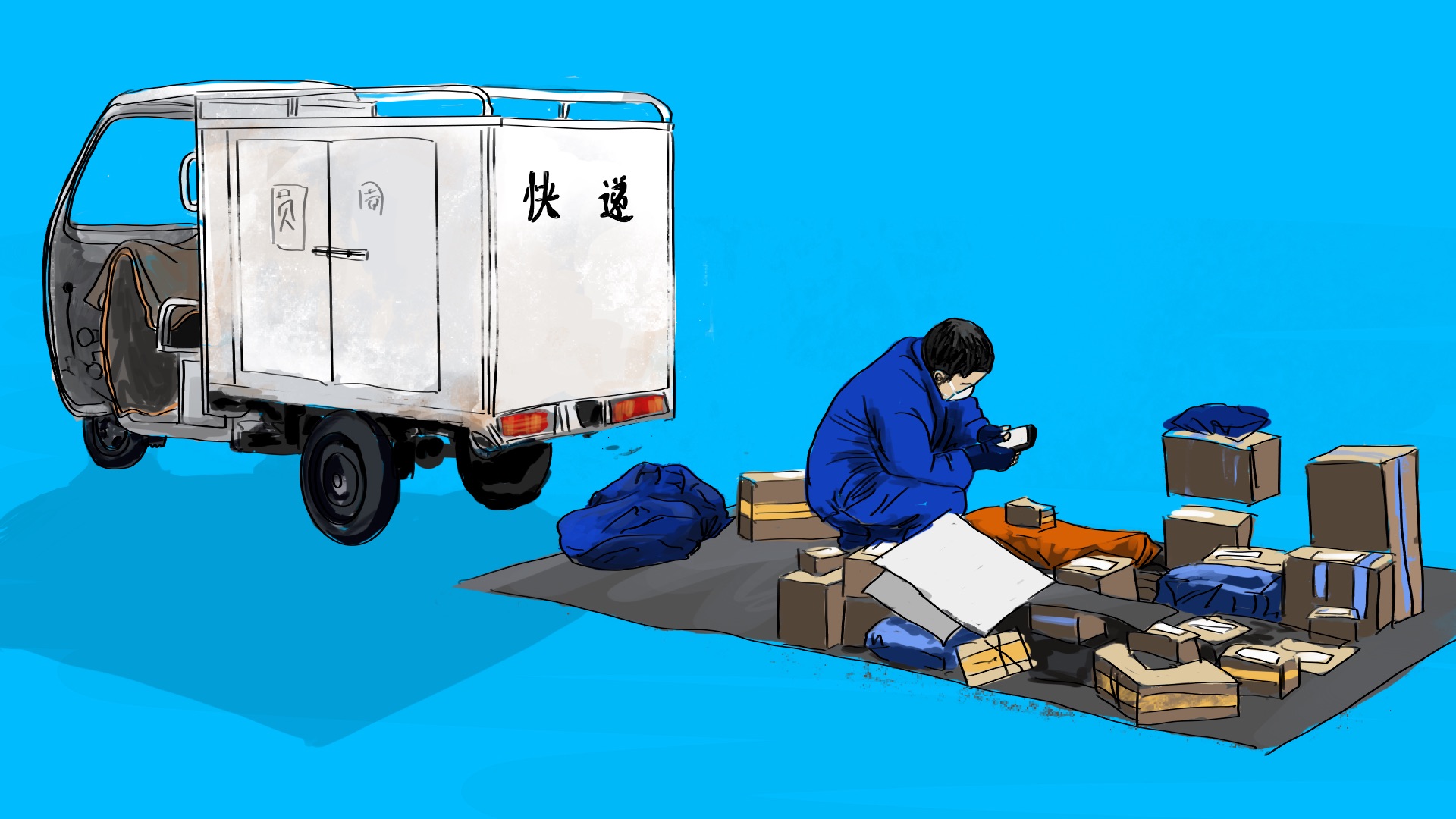How China’s ecommerce helped stamp out the pandemic
Apart from strongman politics, China’s logistical networks — ultra-fast, thoroughly diffused, and widely trusted — helped a nation weather lockdown during COVID-19.

Last April, as the pandemic moved through the Western world, China’s economy came roaring back in full force. Delivery drivers on rickety scooters zipped through tree-lined streets while construction workers drilled into concrete slabs, filling the air, again, with the hurly-burly so familiar to city life.
China’s pandemic response — brutal yet effective — has been heralded by nationalists as a pageantry of authoritarian excellence. Last year, China was the only economy among the major countries to grow rather than shrink, a point that has enthralled China’s state media and foreign ministry. But while the Communist Party has effectively steered the country’s pandemic response, its role in the larger story has been exaggerated. Years from now, when scholars and historians return to tell the story of China in 2020, the free market may have its own chapter.
In the past two decades, major transformations have turned China’s economy from a brick-and-mortar system fueled by cash to a digital one driven by door-to-door deliveries. In the early 2000s, China accounted for less than 1 percent of all digital transactions worldwide; in 2016, the number climbed to 40 percent, more than double the U.S., which is in second place.
Matthew Crabbe, a market analyst at Mintel Asia, told me that the dizzying pace of digitization in China, relative to its Western counterparts, was the result of two different market “legacies”: “The idea of ‘High Street’ or ‘Main Street’ America was that you could get everything from anywhere,” Crabbe said. “So people are already comfortable with that and they didn’t need to go online.”
In Western markets, decades of middle class consumerism entrenched offline shopping habits. Traditional retail giants like Walmart and Target in the U.S. and John Lewis and Marks & Spencer in the U.K. already delivered many of the advantages — cheap prices, broad selections, convenience, and cross-country consistency — that ecommerce companies like Amazon would promise more aggressively years later. For citizens in the U.S. and the U.K. — two societies hit hardest by the pandemic — consumption and physical movement went hand in hand. In China, however, where no such legacy existed, offline habits were not deeply ingrained. When mainstream consumerism began in earnest in the 2010s, consumers were open to new possibilities: an online revolution was one.
In the 2010s, the spectacular rise of ecommerce companies such as Alibaba and JD.com remade China into the world’s largest digital market, with eight out of every 10 people having shopped online. To accommodate, a highly efficient and diffuse logistics infrastructure sprang into existence. In 2013, Cainiao, the logistical arm of Alibaba, announced the goal of realizing 24-hour delivery for any product, to anywhere in China. (Alibaba invested $43 billion to kickstart the project.) China’s markets were beginning to look very different from their U.S. counterparts, which still displayed the mark of an earlier era. While Western economies were still dependent on people taking weekend trips to the mall, China’s was running on scooter batteries.
In many ways, the transition to digital markets — and the highly efficient delivery networks that prop them up — are the latest iterations of free market capitalism: fast deliveries save costs and convenience attracts sales. But by allowing purchases to take place on the couch rather than the cash register, the delivery infrastructure also became a quarantine godsend. “Home delivery played a very important role amid the coronavirus outbreak,” Hu Xingdou, a political economist in Beijing, told the South China Morning Post. “To some extent, it prevented people from starving, especially in cases when local governments took extreme measures to isolate people.”
After President Xí Jìnpíng 习近平 sealed off Wuhan on January 23, much of the nation confronted a nationwide lockdown. Citizens were confined to their own residential compounds, some with limited access to necessities like food, toilet paper, and disinfectant. Home delivery services became the primary means of reconciling basic needs with stringent government orders. Every morning in Wuhan, residents passed a paper with their order number onto a community worker, who would pick up deliveries from a courier at the residential gates. The public sector may have led the pandemic response, but success hinged on China’s private networks.
The value of logistics infrastructure was not unique to China: Western ecommerce giants like Amazon also helped citizens manage quarantine in other parts of the world. But in China, where quarantine demands were among the harshest, and dispersed cities prevented close bureaucratic coordination, the reliance on an extant delivery network — diffuse, efficient, and ubiquitous — proved indispensable. “Imagine if it had not been in place across China, the kind of logistical problems the government would have faced,” said Crabbe.
Throughout March and April, in another testament to the value of ecommerce during the February lockdown, Chinese citizens took to social media to express their appreciation for delivery drivers, what some Chinese affectionately call “little delivery boys” (快递小哥 kuàidì xiǎo gē). At a State Council news conference last March, one nervous-looking driver named Lǐ Jié 李杰, who was invited to speak on behalf of his company Alibaba, called on community workers to stop preventing drivers from entering residential neighborhoods. The request implied that the harsh government mandates were counterproductive. “I believe that the 3 million other delivery boys share the same view as me: we just want to do the best we can to serve our customers quickly and safely during the pandemic,” Li said. “Our goal is to reduce the time customers spend leaving their homes and walking around.”
Users on the microblog Weibo overwhelmingly expressed sympathy with Li’s position. “A member of the lowest rung of society,” one netizen wrote, “saying what all of us are truly thinking. You go little guy.” Indeed, delivery workers were the antithesis of sweeping state mandates: they were engines of China’s private economy, catering to every individual need in the middle of a deadly pandemic. For a country that has thus far boasted its government’s response as a decisive factor, Li’s comments made for an uneasy broadcast. Might the government’s one-size-fits-all policies have done more harm than good? Which group made the greater public contribution during the pandemic period, the government or the private sector?
The state’s answer was a predictable one. A recent exhibition in Shanghai celebrating China’s “fight against the pandemic” featured the photo of a delivery driver, squatting outside the entrance of a residential area delivering a parcel. “Delivery boys played a significant role in the operation of the city during the pandemic,” an article on the exhibition stated. “Like the city’s blood vessels, they took on the mission of working during the special period, supplying thousands of families with physical and emotional needs.” Public commemorations of China’s pandemic response have co-opted the image of the delivery driver into a symbol of patriotism. Yet for a group that had gotten the short end of the stick in China’s ecommerce revolution, the association feels somewhat strained.
As stories of China’s handling of the pandemic continue to evolve, the party’s heroic narrative is due for a revision. The rapid curtailment of cases and the economy’s rebound may have less to do with the heavy hand of government than the dynamism of free markets. The shift to online commerce, spurred by tech companies like Alibaba in China, began long before the arrival of COVID-19. And those early market trends — digital transactions, supply chain networks, and a robust delivery workforce — paid dividends during the most dangerous periods of the pandemic. Citizens acclimated to the digital transition welcomed online consumption and the adoption of new technologies. Years from now, when scholars study how China managed the obstacles standing in the way of its meteoric rise, they may find the economic story more compelling than the political one.






